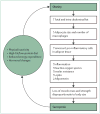Age-related and disease-related muscle loss: the effect of diabetes, obesity, and other diseases
- PMID: 24731660
- PMCID: PMC4156923
- DOI: 10.1016/S2213-8587(14)70034-8
Age-related and disease-related muscle loss: the effect of diabetes, obesity, and other diseases
Abstract
The term sarcopenia refers to the loss of muscle mass that occurs with ageing. On the basis of study results showing that muscle mass is only moderately related to functional outcomes, international working groups have proposed that loss of muscle strength or physical function should also be included in the definition. Irrespective of how sarcopenia is defined, both low muscle mass and poor muscle strength are clearly highly prevalent and important risk factors for disability and potentially mortality in individuals as they age. Many chronic diseases, in addition to ageing, could also accelerate decrease of muscle mass and strength, and this effect could be a main underlying mechanism by which chronic diseases cause physical disability. In this Review, we address both age-related and disease-related muscle loss, with a focus on diabetes and obesity but including other disease states, and potential common mechanisms and treatments. Development of treatments for age-related and disease-related muscle loss might improve active life expectancy in older people, and lead to substantial health-care savings and improved quality of life.
Copyright © 2014 Elsevier Ltd. All rights reserved.
Conflict of interest statement
We declare tbhat we have no competing interests.
Figures



References
-
- Candow DG, Chilibeck PD. Diff erences in size, strength, and power of upper and lower body muscle groups in young and older men. J Gerontol A Biol Sci Med Sci. 2005;60:148–56. - PubMed
-
- Lauretani F, Russo CR, Bandinelli S, et al. Age-associated changes in skeletal muscles and their effect on mobility: an operational diagnosis of sarcopenia. J Appl Physiol (1985) 2003;95:1851–60. - PubMed
-
- Rosenberg IH. Sarcopenia: origins and clinical relevance. J Nutr. 1997;127(suppl):990–91. - PubMed
-
- Thomas DR. Loss of skeletal muscle mass in aging: examining the relationship of starvation, sarcopenia and cachexia. Clin Nutr. 2007;26:389–99. - PubMed
-
- Baumgartner RN, Koehler KM, Gallagher D, et al. Epidemiology of sarcopenia among the elderly in New Mexico. Am J Epidemiol. 1998;147:755–63. - PubMed
Publication types
MeSH terms
Grants and funding
LinkOut - more resources
Full Text Sources
Other Literature Sources
Medical

